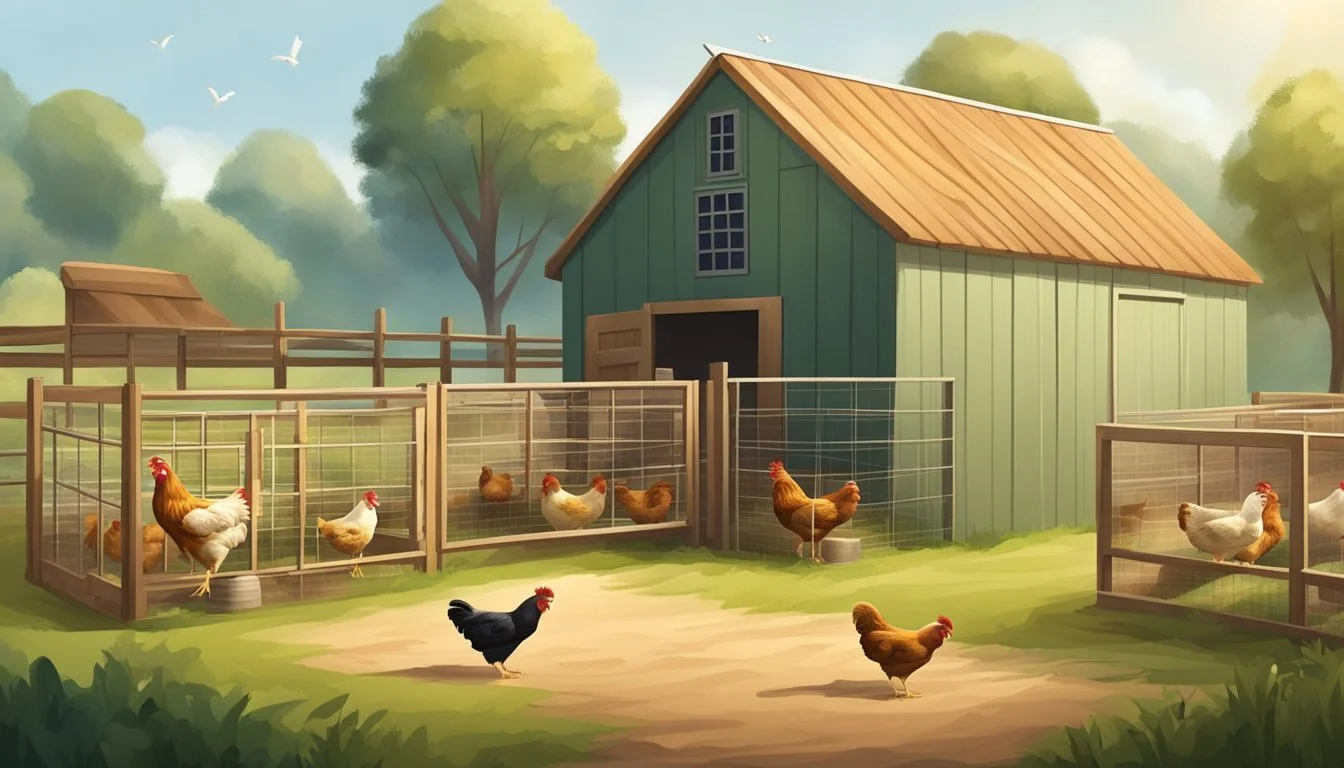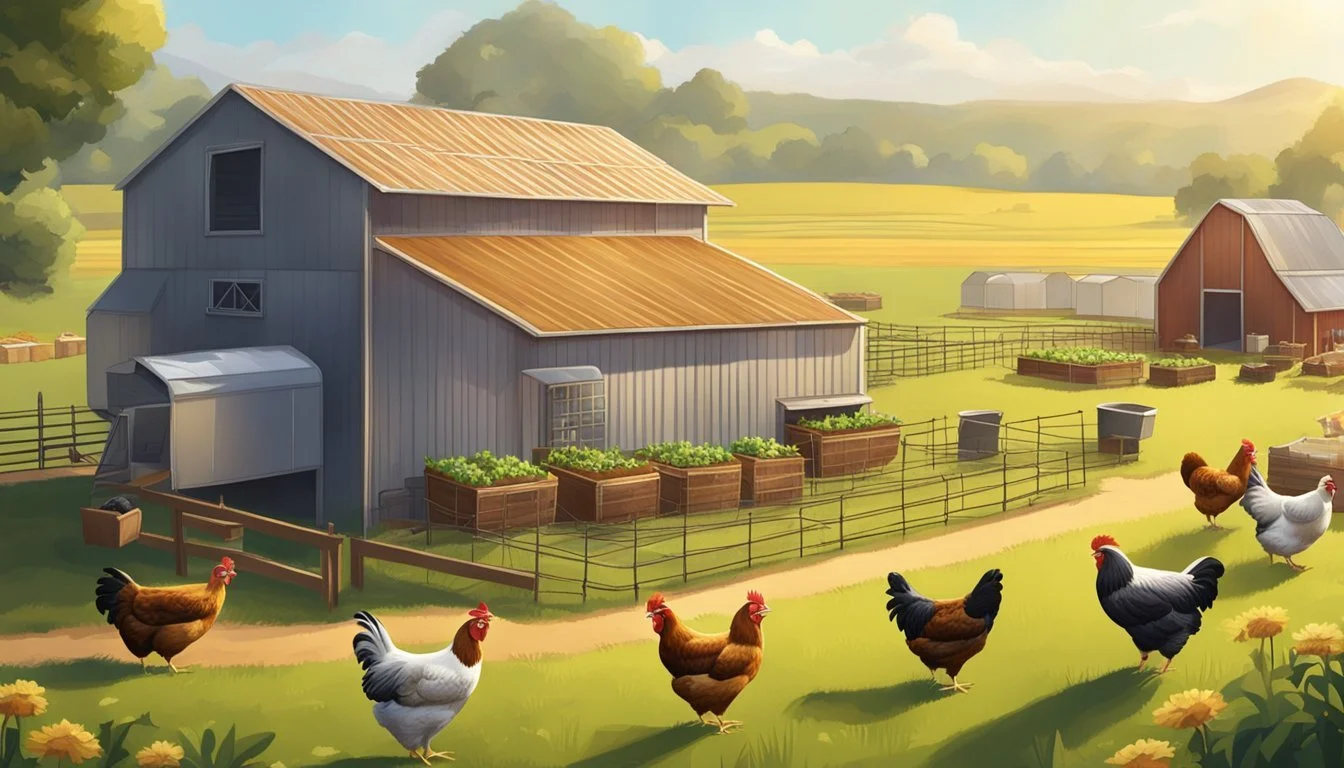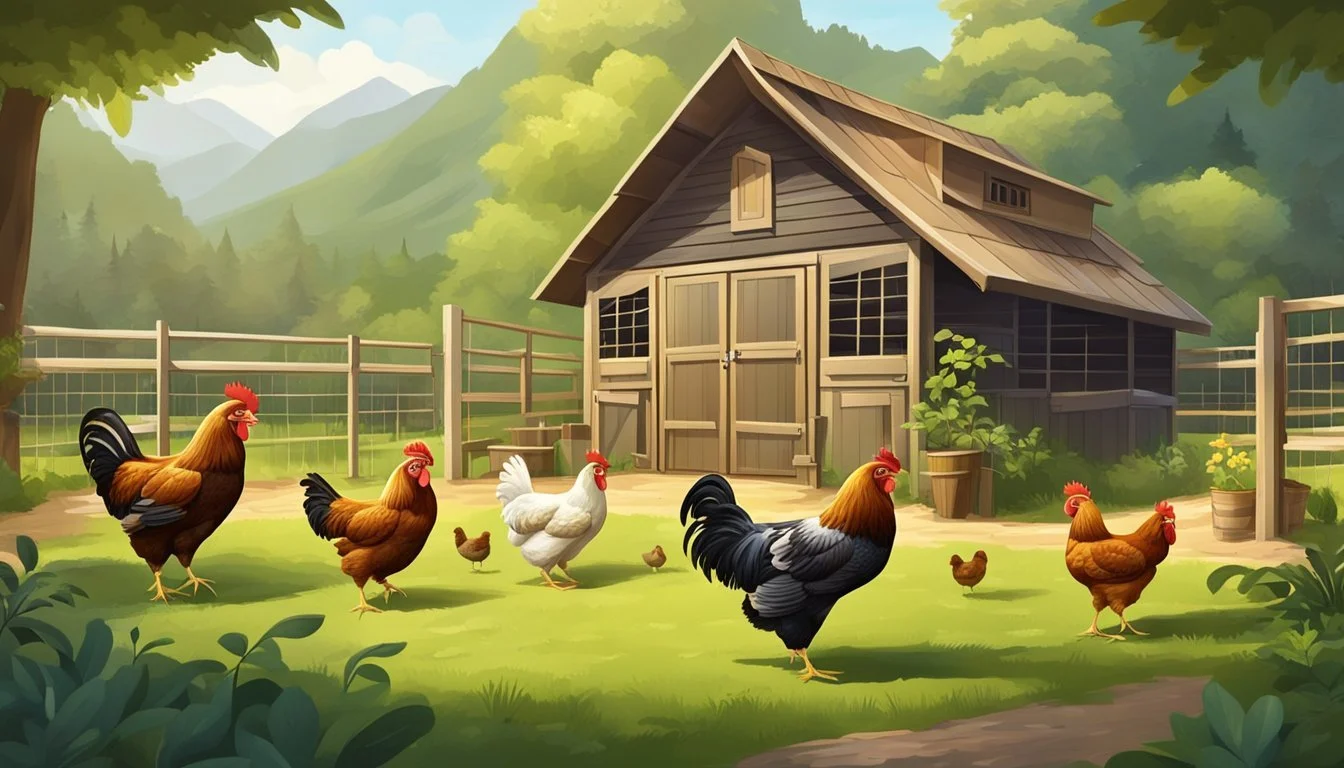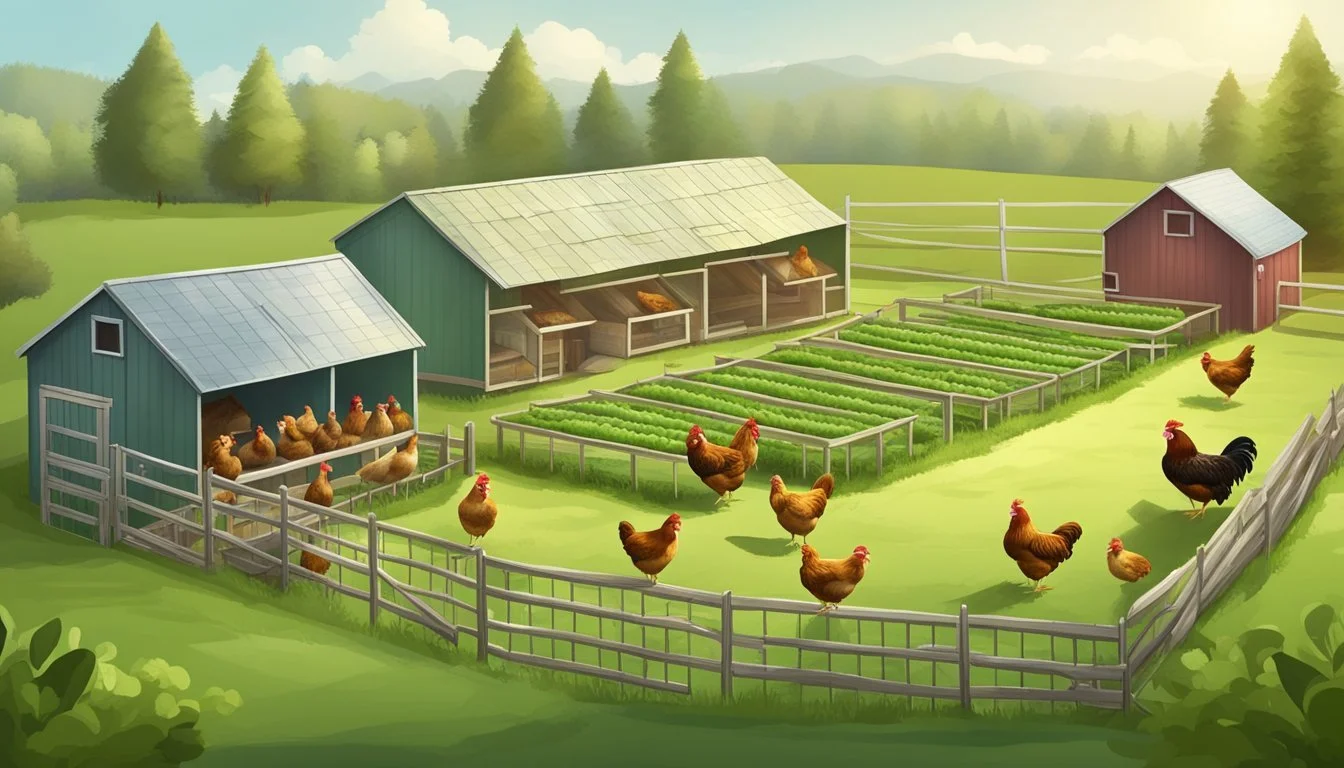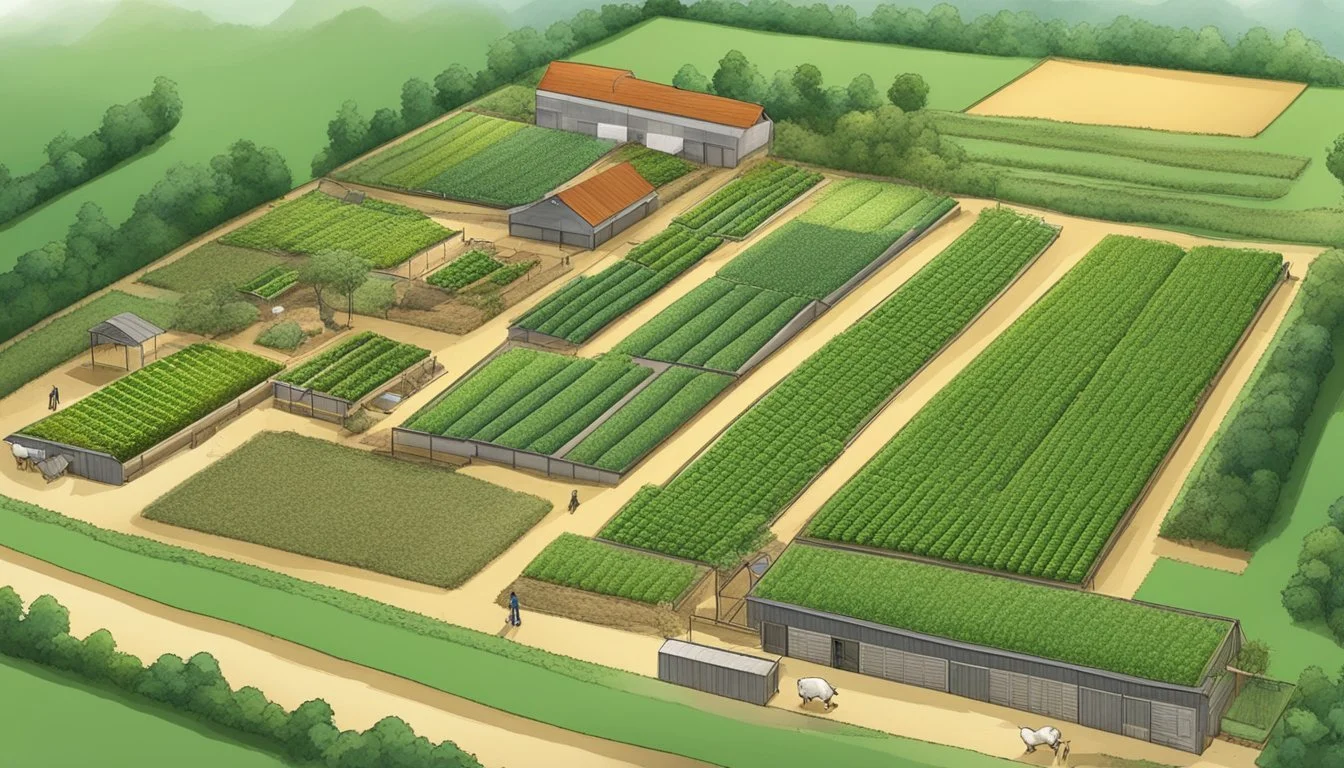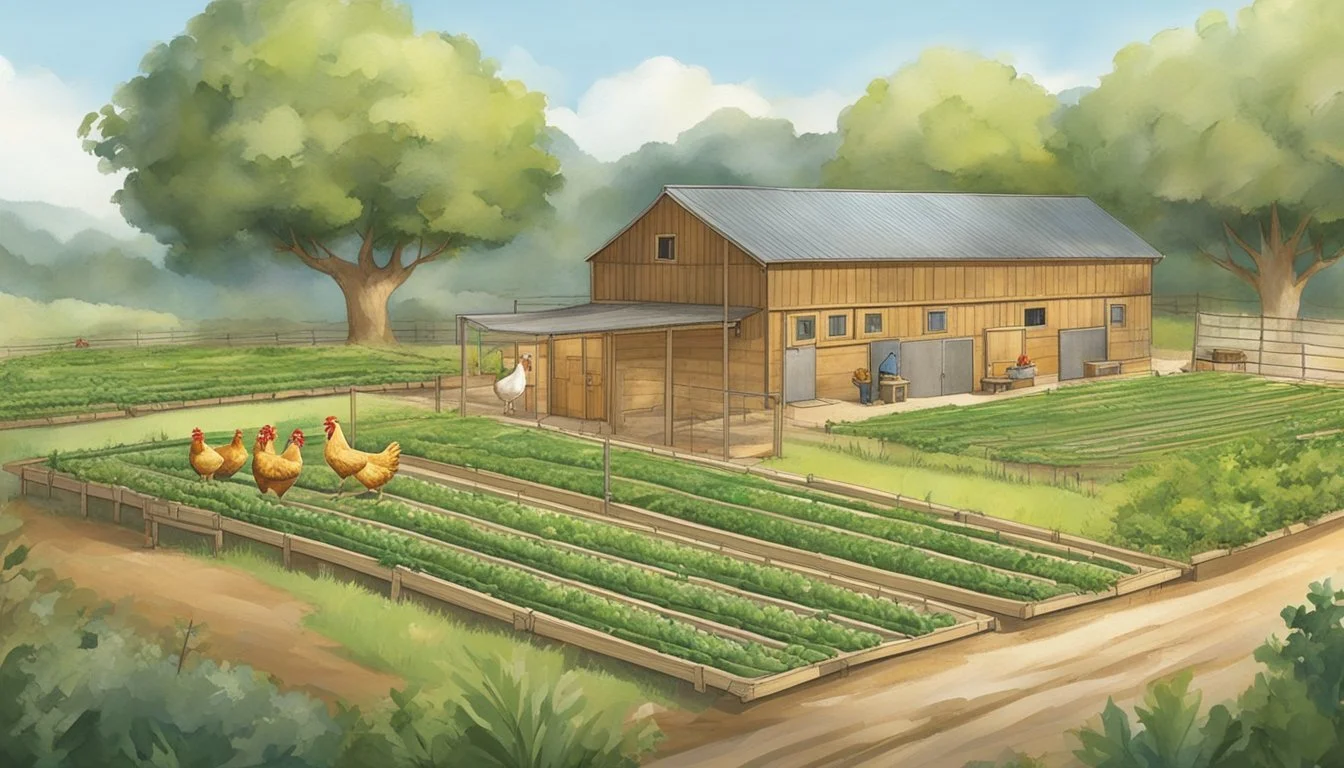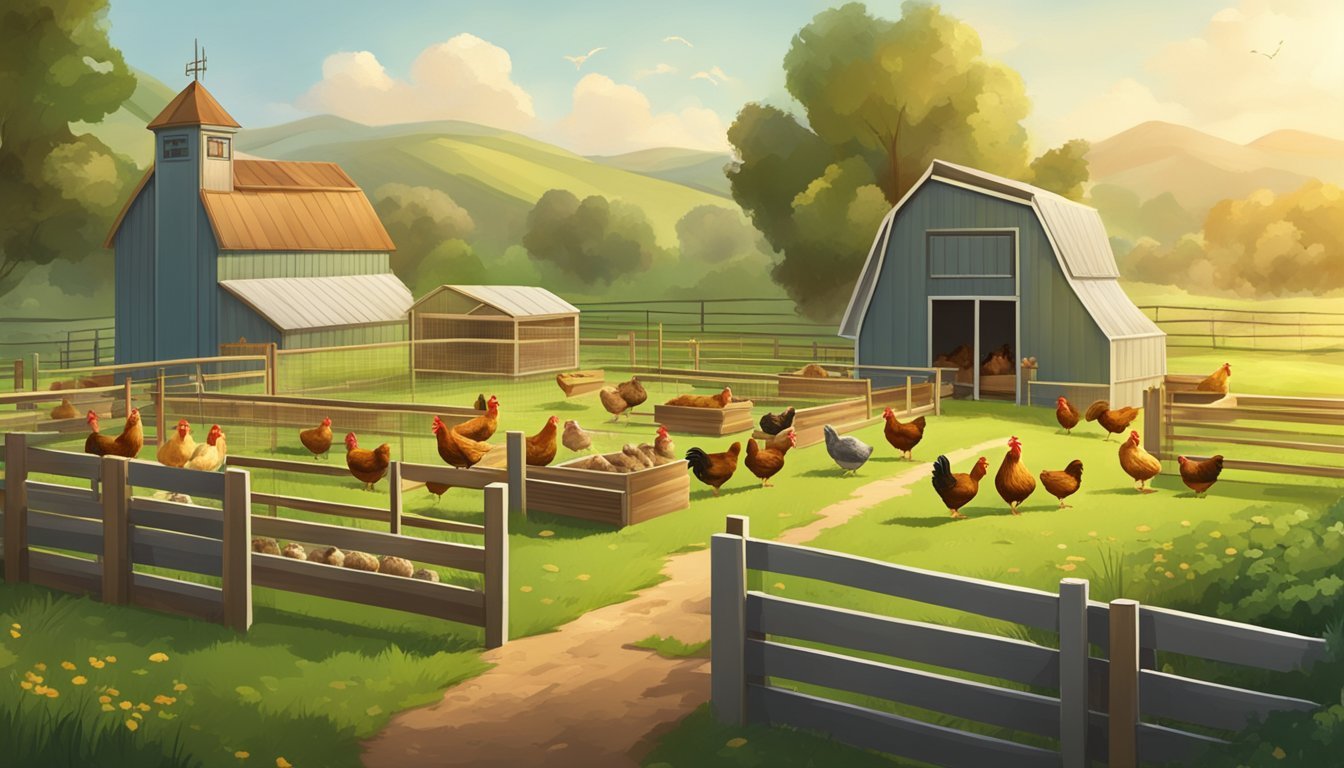How to Manage a Small-Scale Organic Chicken Farm
Essential Tips for Success
Managing a small-scale organic chicken farm requires dedicated attention to sustainable practices and adherence to organic farming principles. Organic chicken farming stands out as a sector within poultry farming where small-scale farmers commit to raising chickens without the use of synthetic fertilizers, pesticides, genetically modified organisms (GMOs), or animal by-products in the feed. In doing so, they contribute to sustainable agriculture by maintaining ecological balance and promoting biodiversity.
For small-scale farmers interested in this method, starting an organic chicken farm involves a thorough understanding of both the biological and economic aspects of farming. To maintain the health and productivity of the flock, farmers must ensure their chickens have access to outdoor spaces where they can forage, which is integral to their welfare and the organic nature of the operation. In addition, farmers must be aware of the market dynamics and create a financial strategy that accounts for the often higher costs and premium prices associated with organic products.
Farmers also face the task of navigating regulations, obtaining necessary certifications, and implementing effective methods to manage flock health organically. This includes choosing the right organic feeds, managing pests and diseases without synthetic chemicals, and ensuring the production process remains transparent and traceable, a key aspect in retaining organic integrity and consumer trust.
Understanding Organic Poultry Farming
Organic poultry farming merges the sustainable principles of organic agriculture with poultry raising to create a farming system that respects natural processes. It focuses on maintaining the health of both the chickens and the ecosystem.
Principles of Organic Farming
Organic chicken farming is underpinned by stringent principles that prohibit the use of synthetic fertilizers, antibiotics, genetically modified organisms (GMOs), and encourages preserving biodiversity and soil quality. To receive organic certification, farmers must adhere to state and national regulations that ensure these standards are met. They must also guarantee that poultry has access to the outdoors, which contributes to healthier, more nutritious food. A fundamental resource for understanding these principles can be found in this comprehensive guide to organic poultry.
Benefits of Organic Chicken Farming
Organic chicken farming offers numerous benefits. It supports sustainable agriculture, by enhancing soil fertility and promoting biodiversity. Pasture-raised chickens are noted for their improved flavor and higher levels of omega-3 fatty acids. From an economic perspective, organic products can fetch premium prices in the market, directly benefiting the farmer's bottom line, as detailed in the benefits of small-scale organic farming.
Challenges of Organic Farming
Despite the benefits, organic farming faces challenges such as higher production costs, the need for more labor-intensive practices, and the complexity of securing financing. Balancing these challenges while ensuring compliance with state regulations requires careful planning and management. Climate change also poses a significant threat to the stability and predictability of farming operations, making the need for adaptable and resilient farming methods crucial.
Setting Up the Farm
When establishing a small-scale organic chicken farm, selecting an optimal location, designing efficient farm infrastructure, and navigating the process for organic certification are critical steps.
Choosing the Right Location
The location for an organic chicken farm must meet specific criteria to ensure the sustainability and well-being of the flock. Ideal sites should have access to ample sunlight, good drainage, and high-quality soil, as these factors contribute to the growth of healthy pasture. Small-scale farmers should seek land that supports pastured poultry, ensuring that chickens have enough space to roam, forage, and exhibit natural behaviors. Securing a location that is shielded from high winds and free from flooding will provide a safer environment for the flock.
Designing the Farm Infrastructure
The infrastructure of a small-scale organic chicken farm comprises several components:
Housing: Build or set up a chicken coop that is safe, well-ventilated, and insulated against weather extremes. It should provide protection from predators and meet space requirements per bird.
Fencing: Durable fencing is necessary to protect chickens from predators and to define the pasture boundaries for the flock's grazing area. Ensure that it is tall and buried deep enough to prevent escapes or intrusions.
Shelters: In addition to the main coop, provide mobile shelters in the pasture to offer shade and refuge.
Feeders and Water Containers: Equip the farm with sufficient feeders and shallow water containers to prevent drowning, following the guideline that there should be one feeder and water container per every four to six birds.
Laying out the farm with consideration for the operation's workflow, from feeding to egg collection, can improve efficiency and enhance biosecurity.
Obtaining Organic Certification
Gaining organic certification often involves satisfying stringent USDA standards and adhering to state regulations. Small-scale farmers must document their practices, including feed ingredients and health management strategies. Using 100% organic feed and avoiding synthetic fertilizers and GMOs are central to maintaining certification. The site selection and farm infrastructure must also support organic standards, emphasizing animal welfare and environmental health. Engaging with the certification process early can streamline future operations and prove advantageous in the market.
Breeds and Breeding
For success in organic chicken farming, selecting the right breeds and managing the breeding process are fundamental. The choice of breed impacts both meat and egg production, while breeding and hatchery management are critical for sustaining flock health and farm productivity.
Selecting Chicken Breeds
When it comes to choosing chicken breeds for organic farming, there are numerous factors to consider such as the purpose of the farm (meat production, egg production, or both), climate adaptability, and the farm's capacity to maintain heritage breeds. For meat chickens, faster-growing breeds like the Cornish Cross are commonly selected due to their quick maturity and large breast meat yield. Conversely, for egg production, breeds like the Leghorn are favored for their high lay rate. Farmers interested in dual-purpose breeds might opt for the Rhode Island Red, Sussex, Australorp, or Plymouth Rock, which provide a balance between meat and egg production.
Heritage breeds, such as the Barred Plymouth Rock or Delaware, are often chosen for their hardiness, long productive lifespan, and ability to thrive in pasture-based settings. These breeds might grow slower and lay fewer eggs, but they are valued for their genetics and contribution to poultry farming biodiversity.
Breeding and Hatchery Management
Effective hatchery management begins with a good breeding strategy. The selection of robust layer breeds is crucial for a sustainable layers breeding program. In managing a hatchery, an incubator plays a crucial role in controlling temperature and humidity conditions, essential for the hatching success of day-old chicks.
Breeding also involves careful genetic selection to ensure strong, healthy, and productive birds. The genetics of breeds like Rhode Island Red and Australorp contribute to disease resistance and better adaptability to organic farming conditions—traits that are essential for the longevity of the farm. Ensuring that breeding pairs are well-suited for each other helps maintain the desirable characteristics of a breed and enhances the overall success of the hatchery's output.
Daily Operations
Effective daily management is crucial for a successful small-scale organic chicken farm. They must focus on providing nutritious food, ensuring chicken health, and using sustainable pastured poultry systems to raise chickens with better flavor and higher levels of omega-3 fatty acids.
Feeding the Chickens
Organic chicken farms prioritize feeding chickens 100% organic feed to avoid synthetic fertilizers, pesticides, GMOs, and animal by-products. They should use efficient feeders to minimize feed costs and waste. Regular checking and refilling are part of the daily care process to ensure the chickens have access to fresh feed. The choice of chicken feed is significant, as it impacts both the chickens' health and the end product's flavor.
Managing Chicken Health
The well-being of the flock is paramount, as healthy chickens provide better quality meat and eggs. Farms must have a routine that includes monitoring for signs of diseases, administering necessary vaccinations, and ensuring there is no need for antibiotics, which are not used in organic farming. Providing clean water, shelter, and daily care to check each chicken's health status forms the core activities in this area.
Implementing Pastured Poultry Systems
Pastured chicken or free-range systems allow chickens to roam freely, forage for their natural diet, and exercise, which enhances the quality of their meat and eggs. Farmers may use movable shelters, such as chicken tractors, to protect the flock from predators and the elements while allowing for regular movement to fresh pasture. This practice not only supports animal welfare but also leads to products rich in omega-3 fatty acids owing to the diverse diet the chickens enjoy.
Housing and Equipment
When managing a small-scale organic chicken farm, one must prioritize the design and upkeep of the chicken coops, as well as the procurement of essential poultry farming equipment. Proper housing ensures the safety and high egg production of the birds, while the right equipment streamlines daily operations.
Building and Maintaining Coops
The chicken coop acts as the primary shelter, protecting chickens from predators and harsh weather. A small farm will typically need coops that are robust yet flexible. The structure should accommodate sufficient nesting boxes for egg laying and roosting bars for sleeping. Coops must also allow for enough space to prevent overcrowding, aligning with sustainability practices by promoting better health in poultry.
For safety, sturdily constructed coops should use hardware cloth for fencing rather than chicken wire, as it's more effective at deterring predators. Additionally, netting might be necessary to secure the outdoor areas from aerial threats. Maintenance involves regular checks and repairs to ensure no gaps or vulnerabilities have formed that could invite unwanted visitors.
Essential Poultry Farming Equipment
Every small-scale organic chicken farm requires key equipment to operate efficiently. This includes:
Feeders: Proper feeders ensure chickens have access to their organic feed, minimizing waste and keeping the feed clean.
Waterers: Clean water is crucial, and waterers should be refilled daily to maintain hygiene.
Nesting Boxes: These should be strategically placed and lined with straw or shavings for comfort and to support egg production.
Fencing: Adequate fencing safeguards chickens from wandering off and protects them from ground-level predators.
It is imperative that equipment is routinely inspected and cleaned to ensure the shelters remain safe and that the chickens are living in a stress-free environment, which directly affects their well-being and productivity.
Product Management
In managing a small-scale organic chicken farm, product management encompasses efficient egg production and collection, strict meat processing protocols, and clear packaging and labeling to ensure a premium product reaches the consumer.
Egg Production and Collection
Egg production in organic chicken farming relies on using 100% organic feed to maintain the highest quality standards. Farmers should provide ample space for nesting boxes and roosts to support the hen's natural behaviors, resulting in optimal egg production. It is imperative to collect eggs regularly to ensure freshness; in addition, clean and inspect them to meet the stringent organic standards.
Meat Processing and Quality
Proper meat processing is crucial for ensuring that the chicken's flavor and texture meet consumer expectations for a premium product. Only organic chickens of the right roaster size should be selected for meat production. Processing should be carried out in a USDA-approved facility to ensure food safety, and organic protocols must be strictly followed to preserve the meat's organic integrity.
Packaging and Labeling
The final step in product management is packaging and labeling. Packaging should protect the integrity of the poultry products while being sustainable. Clear labels stating the product is "Organic" with a certified logo help reassure customers of the product's quality. Labels must comply with regulations and include relevant information such as farm name, product weight, and a tracking code for traceability.
Marketing and Business Strategies
In managing a small-scale organic chicken farm, it is crucial to deploy effective marketing and business strategies. These should focus on understanding the target market, establishing a distinct brand identity, and meticulously crafting a business plan that outlines the pathway to a profitable business.
Understanding Your Market
Market analysis is the cornerstone for any successful poultry business. Small farms must identify and evaluate their niche markets, considering venues such as local restaurants and farmers' markets, which often seek high-quality, sustainably-raised poultry. A thorough grasp of the target audience's preferences can enhance return on investment by aligning the products with consumer demand.
Building a Brand
A cohesive branding strategy elevates a business's visibility and reputation. Creating a memorable logo and consistent visual identity on social media and packaging can differentiate a small farm from competitors. Employing storytelling about the farm's sustainable practices can also engender loyalty among customers who are mindful of the origins and ethics of their food.
Creating a Business Plan
A comprehensive business plan is instrumental in charting a course for a profitable business. It should articulate clear objectives, such as revenue targets and growth milestones, alongside financial projections that underscore the farm's potential for profitability. The business plan also serves as a guide for making informed decisions regarding investment in resources and scaling the operation sensibly.
Financial Management and Growth
Successful financial management and growth are crucial for small-scale organic chicken farmers aiming to establish a profitable and sustainable business. Developing a solid business plan enables them to understand their financial stance and guides them in making informed decisions that affect expansion and diversification.
Navigating Financial Challenges
Small-scale farmers often face hurdles in financing due to limited capital and the need for a substantial return on investment to keep their operations afloat. Effective financial planning starts with a comprehensive budget that tracks all expenses and income. It is essential for farmers to maintain detailed records and perform regular financial analysis, possibly by utilizing tools like the Extension Farm Financial Statement which simplifies this process. They should also explore various funding sources, including grants that are specifically designed to support organic farming practices.
Expanding Your Farm Business
When considering expanding their business, farmers should evaluate the potential returns against the investment required to move to a larger scale. Expansion may involve increasing the number of poultry, enhancing the production area, or scaling up poultry products to meet demand. Direct sales to restaurants or through farmer's markets can lead to higher profit margins. Additionally, focusing on sustainable practices can not only contribute to the farm's brand image but also attract customers willing to pay a premium for organic products.
Exploring Diversification and Value-Adding
Diversification and adding value to existing products are strategies that can minimize risks and increase revenue streams. Farmers should consider processing their organic chicken to create various products like sausages or marinated meats, which could yield a higher return on investment. They might also venture into related businesses, such as selling eggs or offering agritourism experiences. This approach not only creates a profitable business model but also helps in establishing financial resilience against market fluctuations.
By focusing on robust financial management, leveraging growth opportunities, and using diversification strategies, small-scale organic chicken farmers can develop a thriving and resilient business.
Regulations and Compliance
Managing a small-scale organic chicken farm involves adhering to various regulatory standards to ensure compliance with organic farming principles. Key among these regulations are the USDA organic standards, which are stringent and serve to maintain the integrity of organic products. Farmers must obtain organic certification, which verifies that their farming practices meet or exceed the federal guidelines set by the USDA.
State regulations may also apply, and they can vary; thus, it is essential for farmers to be informed about their specific state's requirements. This may include zoning laws, environmental regulations, and animal welfare standards that are in addition to federal requirements.
The process of certification typically encompasses a detailed account of the farm’s operational methods, including:
Feed and Housing: Livestock feed must be 100% organic and free from prohibited substances. Housing conditions should meet animal health and welfare standards.
Healthcare Practices: Preventive healthcare practices are encouraged, and the use of synthetic substances for treatment is heavily regulated.
Record Keeping: Detailed records must be maintained to document compliance with organic standards.
Once the certification is granted, ongoing compliance is monitored through regular inspections. The farmer may be advised to consult resources such as Organic Livestock and Poultry Standards by the Agricultural Marketing Service to stay updated with current regulations.
Compliance with these regulations is essential not just for certification, but to maintain consumer trust and sustainably position the farm within the competitive poultry industry. Those failing to comply risk losing their certification and damaging their farm’s reputation.
Resources and Support Networks
For those embarking on small-scale organic chicken farming, a plethora of resources and support networks is available to assist farmers in achieving sustainable agriculture goals. A starting point for many is the Natural Resources Conservation Service (NRCS), which offers fact sheets and guides on implementing conservation practices.
Within these resources, farmers can find:
Guidelines on organic feed
Methods to create sustainable habitats for poultry
Information about maintaining soil quality and water conservation
The USDA has initiated a Microloan Program which is particularly beneficial for new and smaller scale farmers. This loan simplifies the application process and provides:
Loan Feature: Type
Description: Microloan
Loan Feature: Maximum
Description: $50,000
Loan Feature: Purpose
Description: To assist beginning, small and mid-sized farmers
Loan Feature: Usage
Description: Access funds for farming initiatives and improvements
Moreover, they may explore grants specifically tailored for organic farms which promote sustainable practices and can be used to fund various farming needs.
Pioneers like Joel Salatin, a leading advocate for sustainable agriculture, offer wisdom and practical strategies—farmers can delve into his books and lectures for inspiration on running an efficient organic chicken farm.
In addition to these, local farming cooperatives and online forums serve as excellent platforms for farmers to share insights, troubleshoot problems, and exchange best practices. These collective efforts strengthen the organic farming community and underpin its overall success.
Planning for the Future
Small-scale organic chicken farming requires strategic planning to ensure the operation is sustainable and ready to adapt to challenges like climate change. Producers should create a detailed business plan focused on time-efficiency and space-efficiency to maximize their return on investment.
Climate Resilience:
Assess local climate trends and implement adaptive measures for extreme weather events.
Diversify chicken breeds to include those with higher tolerance to heat or cold.
Investment Returns:
Compare initial investment against long-term benefits, factoring in premium pricing of organic products.
Calculate break-even points and project long-term profits based on market analysis.
Facility Design:
Plan coop layouts that optimize space and allow for natural behaviors, which can improve productivity.
Incorporate time-saving technologies for feeding, watering, and manure management.
Sustainable Practices:
Implement rotational grazing to maintain pasture health and reduce feed costs.
Use renewable energy sources for heating and cooling to lessen environmental impact.
Farmers must continuously learn and apply best practices in organic husbandry that align with sustainable farming principles. Adapting to market shifts and consumer demands will be crucial for the future success of organic poultry operations.

